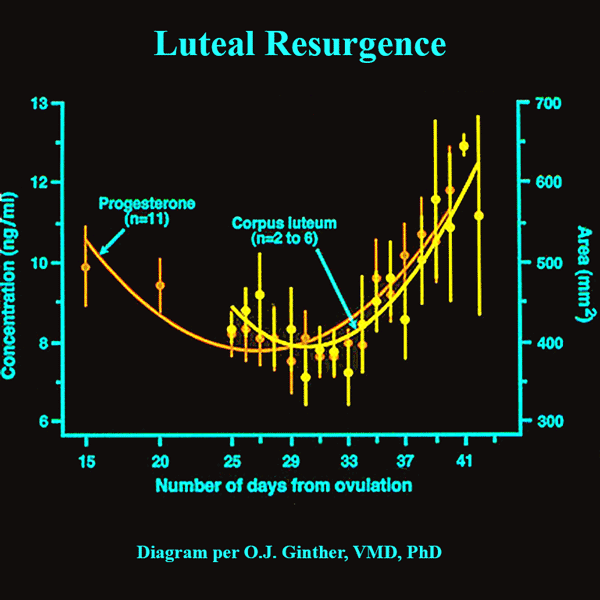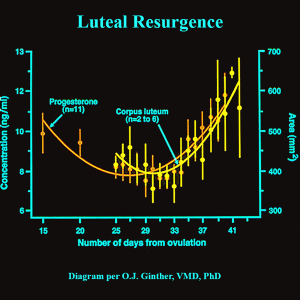Is it True Altrenogest Has an Effect on Progesterone Production?
Pregnant and embryo recipient mares are often treated with supplemental progestins – commonly Altrenogest in the oral form Regumate, or injectable in one of several longer-acting commercial preparations – in an expectation of “low progesterone” levels. There is a significant question as to what number should be applied to “low” – 4 ng/ml is often suggested however many mares have been confirmed as maintaining pregnancies on levels significantly lower (as low as 1.8 ng/ml), so the reliability of that figure is very dubious. Regardless however, does giving the mare Altrenogest have an effect on Progesterone levels in the mare? It should be noted here that Altrenogest will not assay as Progesterone, so an assay result for the latter is not affected by the former. Consequently any differences noted are likely indicative that Altrenogest has an effect on Progesterone production. Crabtree et al. investigated the effects in a retrospective study of embryo transfer recipients mares in a clinical setting in the North of England.
61 mares received embryos using a standard transfer process, the donor mares having been flushed on day 7 (fresh or cooled semen) or day 8 (frozen) post-ovulation. The recipient mares were synchronized to 0 to +4 days with the donor mares. For the purposes of the subsequent evaluations, the day of transfer was identified as day 7. 30 of the recipient mares received long-acting (“Depo”) Altrenogest at 7 day intervals following an initial dose at transfer and through to 42 days (50 mg/ml, BOVA Specials, London, UK), while the remaining 31 mares acting as controls did not receive Altrenogest. Blood samples were collected at 7-day intervals, and assayed for Progesterone (P4) levels.
Seven days after the transfer (day 14), all mares retained an elevated P4 level, however this declined with levels being lower on days 21, 28 and 35. By day 42 there was no statistical difference between the level seen then and at day 14. This decline and recovery is normal and is as a result of primary luteal decline and resurgence. What becomes interesting however is the comparison in P4 levels seen between treated and non-treated mares during this time.
At all time-points between up to day 42, Altrenogest-treated mares had endogenous P4 levels lower than untreated mares. This Altrenogest effect on Progesterone was most pronounced at the 28 day assay. In 40% of the Altrenogest-treated mares, these levels dropped below 3 ng/ml at least once in that time frame, compared to only 3.2% of untreated mares. The odds ratio of a mare which received Altrenogest having a level below 3 ng/ml was 11.2 times greater than an untreated mare. Three of the Altrenogest-treated mares already were showing a level <3 ng/ml by 14 days, with a mean level of 1.6 ng/ml (+/- 1.04). These levels had recovered by day 42 to a mean of 4.03 +/- 1.06. Although the majority of mares showed a luteal resurgence evidencing increased P4 levels by day 42, three Altrenogest-treated mares (10% of the group) underwent a decline from a mean of 5.77 ng/ml at 14 days (+/- 2.01) to a 42 day mean level of 3.7 ng/ml (+/- 1.08).
Interestingly, secondary CL formation during the review time frame was significantly greater in Altrenogest-treated mare than controls (26.67% vs 17.24%). This is possibly as a result of the mare’s own system attempting to reconcile low P4 levels by increasing CL presence.
The overall results confirm research by others that has indicated Altrenogest has a negative effect on Progesterone, suppressing endogenous Progesterone production[1][2]. It was hypothesized that this was as a result of negative feedback on the pituitary LH release, causing reduction of its luteotrophic effect. The paper observes that this is of particular importance if withdrawal of progestin supplementation is being considered during the early pregnancy period. As a consequence of this suppressive effect, confirmation of adequate endogenous P4 levels should be made prior to withdrawal, or the action of withdrawal should be performed after the point where pregnancy maintenance is still reliable on ovarian (CL) P4 production.
(Crabtree JR, Mouncey R, Wilsher S. 2023. Effect of altrenogest on endogenous progesterone during early pregnancy in recipient mares. JEVS 125:104761)
References:
1: Daels PF, DeMoreas J, Stabenfeldt GH, Hughes JP. (1992) The effect of altrenogest on the development of secondary corpora lutea. Proceedings of the 12th ICAR.
2: DeLuca CA, McCue PM, Patten ML, Squires EL. (2011) Effect of nonsurgical embryo transfer procedure and/or altrenogest therapy on endogenous progesterone concentration in mares. J. Equine Vet. Sci. 31, 57-62.




